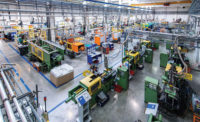With explosive U.S.-market sales virtually demanding the company find a way to get more cars into customers’ hands, Hyundai Motor America isn’t ready to commit to a second assembly plant in the United States, president and CEO John Krafcik told reporters at a media event at the company’s technical center near Ann Arbor, MI, last week. Krafcik (above, at January's Detroit show) insisted that despite a meteoric post-recession sales climb and excruciatingly thin inventories for many models, Hyundai hasn’t made the decision to build another U.S. assembly plant to add to its current site in Montgomery, AL, that started production in early 2005.
Along with the Korea-based Hyundai Group’s affiliated Kia Motors America’s assembly plant in West Point, Georgia, the company currently has capacity to build about 400,000 vehicles in the United States – but the “problem” is that both Hyundai and Kia have been setting monthly and annual sales and market-share gains for several years – and record October sales for both brands were emblematic of their new front-runner status. In October, Hyundai and Kia surpassed their full-year 2010 sales performance, itself a record sales year for both; the two companies combined for 10-month sales just shy of 1 million units. In October, Hyundai’s year-to-date sales were up 21% (compared with its record 2010) and retail sales were up 31 percent.
Hyundai’s looming supply crisis is underscored by its almost nonexistent inventories, which since the Japan earthquake in March have dipped to levels one-third of what is considered healthy. Hyundai said its days supply in July was 21 days, a low for the year, and things had scarcely improved by October, when the company set its new sales record for the month despite a 26-day supply. “We’ve got a lot of headwind, a lot of opportunity to grow the brand in the U.S.,” Krafcik said – while simultaneously sticking to the story that Hyundai, acutely concerned about maintaining quality, isn’t considering another U.S. assembly plant.
Hyundai’s U.S. boss did say the company is projecting a Seasonally Adjusted Annual Rate (SAAR) of sales in 2012 of about 13.5 million units (versus the 12.8-million SAAR predicted for this year), and said Hyundai “should at least grow with the industry next year.” The extra sales aren’t likely to come from increased output from the Group’s two U.S. factories, however (Kia’s Georgia plant makes the Santa Fe midsize crossover for Hyundai). Krafcik said the company already wrung out unexpected combined extra output of about 10% this year, mostly through increased efficiencies, so little more can be expected. Instead, he said, Hyundai sales will increase with incremental volume from new or revised imported models, including an all-new Azera full-size sedan and a redesigned Genesis coupe and sedan, among others.
But Krafcik’s admonitions that Hyundai isn’t working on U.S. expansion plans sound increasingly less convincing. The Alabama plant, which makes the brutally popular new Elantra compact car and its big-selling bigger counterpart, the Sonata midsize sedan, is running flat-out and will make about 330,000 vehicles this year, not to mention the high-volume 2-liter and 2.4-liter 4-cylinder engines used for the Sonata and Kia’s Optima. The plant also is adding construction of the Nu 1.8-liter 4-cylinder engine family, used in the Elantra.
Although Hyundai’s inventories have recovered marginally from their mid-summer lows, there are few signs of relief. Consideration for the brand, Hyundai said, is at an all-time high of 36% and demand is such that incentives are nil. Krafcik said Hyundai’s October incentive spend was an average of $764 per vehicle, the industry’s lowest. Fleet mix has dropped to about 11%.The new Veloster entry-level sport coupe has a days-to-turn rate of eight days, according to company figures. And sales for the new-generation Sonata – a car that in its previous iteration was selling in early 2008 with a $4,000-plus incentive – are tracking to make it the first vehicle in the company’s history to sell more than 200,000 units in the United States. The Elantra compact sedan, which dealers already are barely able to keep on their lots, is adding coupe and 5-door hatchback variants next year.
Unless another economic or natural catastrophe rears up to grenade sales, it seems inevitable Hyundai must address its stretched-to-the-max production. With demand tracking at white-hot levels and a still brimming new-product pipeline, few would be surprised if Hyundai made an announcement of U.S. expansion by the second quarter of next year.
Get our new eMagazine delivered to your inbox every month.
Stay in the know with Quality’s comprehensive coverage of the manufacturing and metrology industries.
SIGN UP TODAY!Copyright ©2024. All Rights Reserved BNP Media.
Design, CMS, Hosting & Web Development :: ePublishing


